Species Recovery
While there remains much conservation to be done and many species to recover, there are some recent successes.
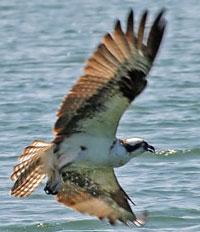 Osprey
Osprey
In 2018 the osprey was down listed from State Endangered to Special Concern. Even though the Osprey, as a Special Concern species, remains a Species of Greatest Conservation Need, this down listing reflects the continued growth and expansion of Osprey in Indiana. This is a great success story and one that speaks to the value of diverse partnerships, the Indiana Nongame Wildlife Fund and the State Wildlife Gran t program .
Northern Leopard Frog
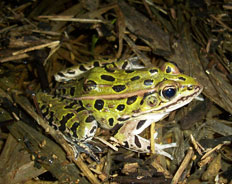
During the latter half of the 20th century Northern leopard frogs experienced considerable declines in several parts of their range, including Indiana, and in 1984 were listed as a Species of Special Concern. However, the frogs have responded well to habitat restoration and are now relatively common in the northern part of the state. As such, in 2017 the Indiana Department of Natural Resources Amphibian and Reptile Technical Advisory Committee voted unanimously to delist Northern leopard frogs. In 2019 will be formally removed as a Species of Greatest Conservation Need.
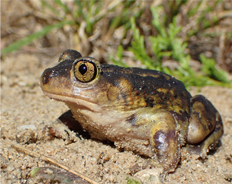
Eastern Spadefoot Toad
Due to survey efforts demonstrating that this species was more common than originally thought, the Eastern Spadefoot Toad was removed as a Species of Greatest Conservation Need in 2018.
Tippecanoe Darter
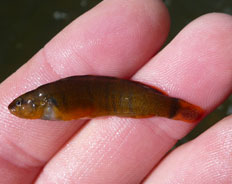
Due to this fish’s ability to burrow deeply into the gravel beds of streams, it was historically under sampled. With improved sampling techniques this fish is found to be more common than originally thought. It was removed as a Species of Greatest Conservation Need in 2018.
Black Bear
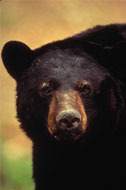
Photo by
US Fish & Wildlife Service
Black Bears are expanding their range in neighboring states. The fact that there have been three confirmed bears in Indiana since 2015 speaks to this expansion into Indiana. As result Black Bear was added to Indiana’s Species of Greatest Conservation Need. Previously, the Black Bear was listed as extirpated. Even though it was added to the list, it is widely considered a good add because of its return to Indiana after over a century of being extirpated.
List of 2017 External (Partnership-based) Research Projects
- Assessing Hellbender Habitat for Potential Reintroductions
- Assessing Juvenile Survival in Eastern Hellbenders
- Efficacy of Using Environmental DNA (eDNA) to Detect Kirtland’s Snake
- Examining Urban and Rural White-tailed Deer: Mortality, Dispersal and Relatedness
- Genetic assessment of Crawfish Frog Populations in Indiana
- Movement and Harvest of Local Mallards from Urban Environments of Indiana
- Snake Fungal Disease Testing in Indiana
- Status of Blanding’s Turtle and Spotted Turtle Populations in Indiana
- Summer Bat Communities on DFW Properties
- Summer Ecology of the Northern Long-eared Bat
- Surveys for the Eastern Massasauga in Indiana
Land Acquisition
With the help of many conservation partners (9 NGO, 7 governmental agencies, 1 private industry and over 50 private citizens), the Indiana Department of Natural Resources has purchased 10,977 acres of habitat within SWAP identified Conservation Opportunity Areas (COA) since January 1, 2015.
|
|
|
| DNR Division | Number of of Acres |
|---|---|
| Fish and Wildlife | 1,989 |
| Forestry | 706 |
| Nature Preserves | 1,254 |
| State Parks & Reservoirs | 3 |
| Totals | 3,952 |
|
|
|
| DNR Division | Number of of Acres |
|---|---|
| Fish and Wildlife | 1,319 |
| Forestry | 424 |
| Nature Preserves |
2,080 |
| Outdoor Recreation | 11 |
| State Parks & Reservoirs | 1 |
| Totals | 3,835 |
|
|
|
| DNR Division | Number of of Acres |
|---|---|
| Fish and Wildlife | 461 |
| Forestry | 1 |
| Nature Preserves | 473 |
| Outdoor Recreation | 229 |
| Totals | 1,164 |
|
|
|
| DNR Division | Number of of Acres |
|---|---|
| Fish and Wildlife | 1,192 |
| Forestry | 109 |
| Nature Preserves | 699 |
| Outdoor Recreation | 9 |
| State Parks & Reservoirs | 17 |
| Totals | 2,026 |
Program Development
State Acres for Wildlife Enhancement Program (SAFE)
Indiana Division of Fish and Wildlife’s Private Lands Program utilized the State Wildlife Action Plan in the development of SAFE. SAFE enrollment started in 2008 and as of July 2018, Indiana has 58,567 acres enrolled. The purpose of the SAFE program is to:
- Restore grasslands and maintain them to ensure healthy, diverse grassland habitat types for the grassland focal species (Northern Bobwhite, Sedge Wren, Henslow’s Sparrow, Grasshopper Sparrow and Ring-necked Pheasant).
- Restore and enhance connectivity of hardwood forests for Indiana Bat.
- To restore wetland habitat on working lands for shorebirds.
For more information on SAFE program contact your Private Lands Biologist
Grasslands for Gamebirds and Songbirds Initiative (GGS)
The State Wildlife Action Plan was utilized in the development of this program by targeting areas of Indiana with the greatest potential for grassland habitat restoration and enhancement. Focal species are Northern Bobwhite, Henslow’s Sparrow, Loggerhead Shrike and Ring-necked Pheasant. In addition, this initiative will greatly benefit pollinator insects. GGS is an award winning partnership between Indiana Division of Fish and Wildlife, US Department of Agriculture, Natural Resources Foundation, private industry, other non-profit organizations and others.
This program gives priority to all State Wildlife Action Plan Conservation Opportunity Areas, rights-of-way along state and federal highways and 100-year flood plains of rivers to establish habitats for grassland dependent wildlife and pollinators.
Lake and River Enhancement Program (LARE)
LARE is grant program designed to provide technical and financial assistance for projects that protect and enhance aquatic fish and wildlife habitat on Indiana’s publicly accessible lakes, streams and rivers. Projects within State Wildlife Action Plan Conservation Opportunity Areas are given higher consideration when evaluating LARE applications.
Indiana Stream and Wetland Mitigation Program
Threats to species and habitats as identified in Indiana’s State Wildlife Action Plan were referenced in the development of this program. Indiana Stream and Wetland Mitigation Program is an in-lieu fee that allows IDNR to sell stream and wetland and mitigation credits for unavoidable impacts to waters of the United States. By referencing Indiana’s State Wildlife Action Plan, IDNR is able to focus credits within Conservation Opportunity Areas.
